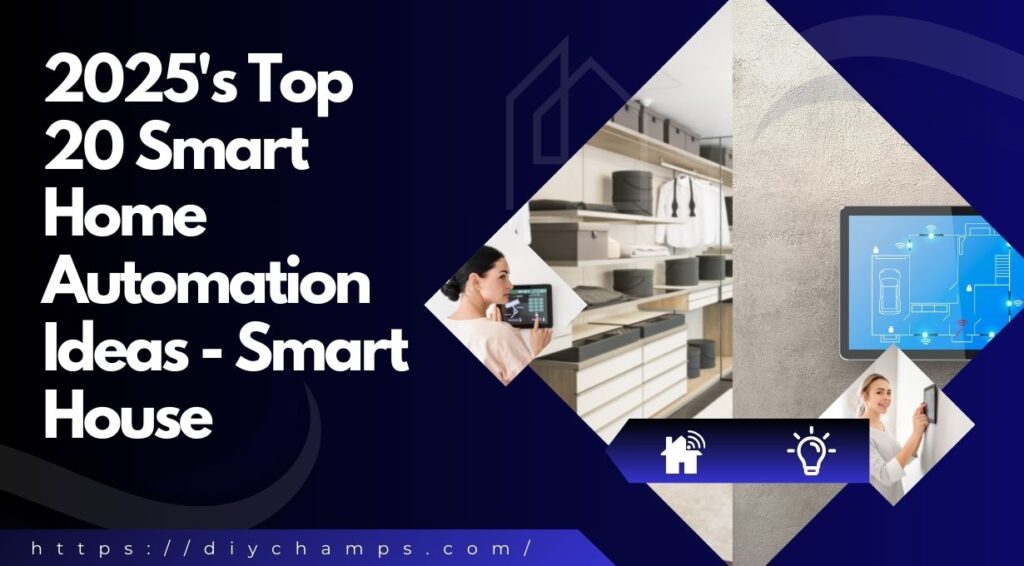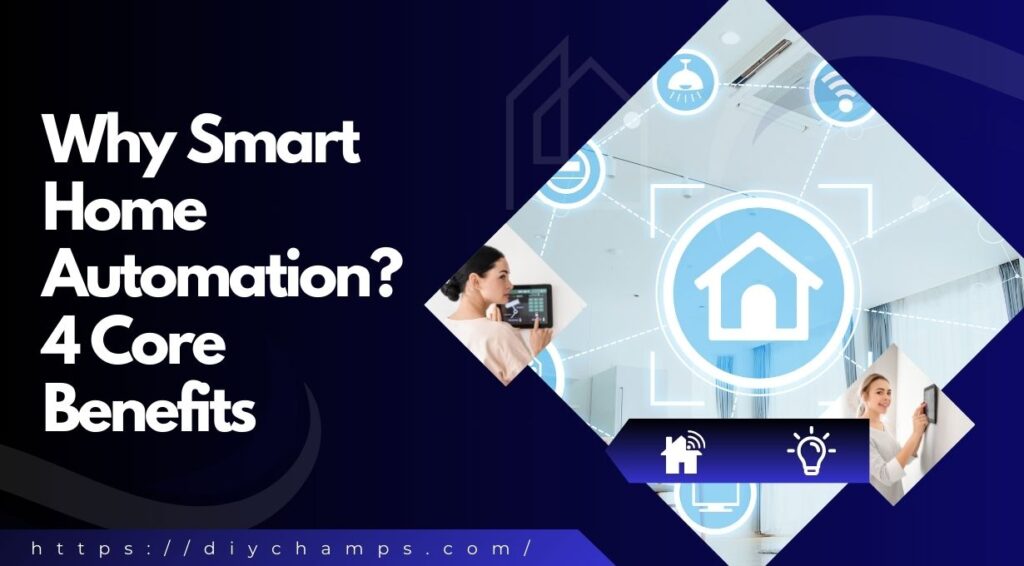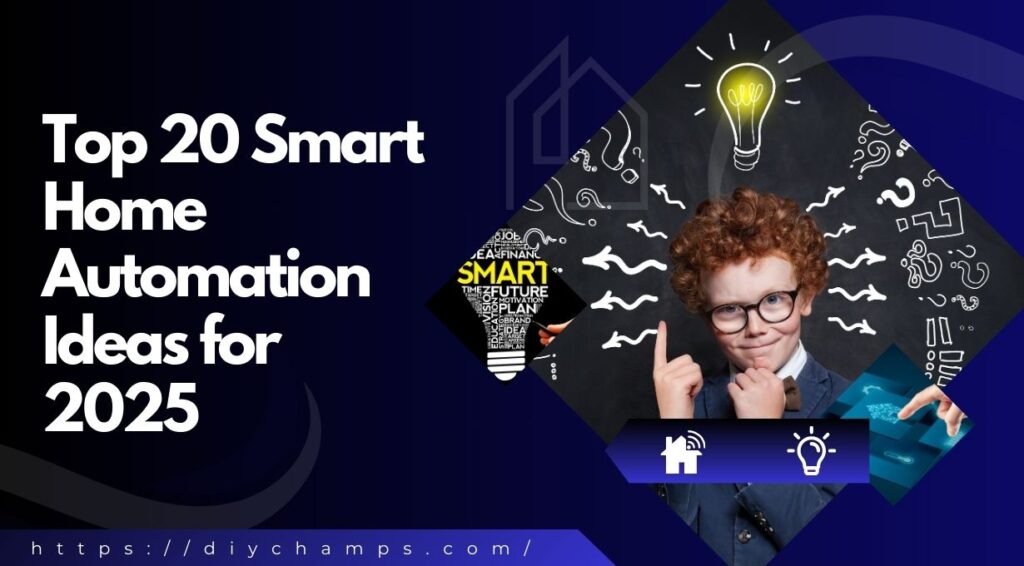Imagine walking into a smart house where the lights adjust to your mood, the air purifier kicks in before you notice dust, and your coffee brews itself as you wake up all thanks to smart home automation ideas designed for 2025. This year isn’t just about gadgets; it’s a revolution in how we live. With AI becoming intuitive, sustainability turning effortless, and DIY tech making automation accessible to all, the future of smart homes is here, and it’s smarter than ever.

The Trends Defining 2025
- AI Integration: Your Home Gets Smarter (and More Personal)
Artificial Intelligence is the heartbeat of modern smart home automation ideas, transforming rigid systems into adaptive companions. Take the Ecobee SmartThermostat Premium, its AI doesn’t just follow schedules, it learns your comings and goings, adjusts temperatures preemptively, and even suggests energy-saving tweaks. Voice assistants like Amazon’s Alexa now handle multi-step routines (e.g., “Goodnight, Alexa” dims lights, locks doors, and plays white noise) while predicting needs like restocking groceries. Even security cameras, such as Google Nest Cam IQ, use AI to differentiate between a delivery person and a lurking stranger, slashing false alarms by 50% . For homeowners, this means a smart house that feels less like a machine and more like a collaborator. - Sustainability: Automation Meets Eco-Conscious Living
If you’re part of the 70% prioritizing energy savings, 2025’s smart home automation ideas deliver. Solar tech like Tesla’s Solar Roof pairs with AI-driven batteries (e.g., SolarEdge Home Battery) to store excess energy for rainy days, cutting grid reliance by up to 80% . Water-saving innovations are equally groundbreaking: Moen’s Flo Smart Water Monitor detects leaks early, saving the average household 10,000 gallons annually . Even windows are getting smarter—Feather River Doors Smart Glass tints automatically to block heat, reducing AC costs by 30% . These aren’t just upgrades; they’re the future of smart homes, where eco-friendliness is automated, not aspirational. - DIY Solutions: Affordable Automation for Every Home
The future of smart homes is democratized. Brands like TP-Link Kasa and Wyze offer plug-and-play devices that turn any house into a smart house without professional help. For under $20, the Kasa Smart Plug Slim lets you automate lamps or coffee makers via voice commands, while Wyze’s $35 Smart Lock replaces traditional deadbolts in minutes . Even advanced systems, like SimpliSafe’s DIY Security Kit, offer 24/7 monitoring for less than $0.50/day . This shift means smart home automation ideas are no longer luxuries, they’re achievable, scalable, and tailored to budgets.
Why 2025 is the Year to Act
The future of smart homes hinges on three 2025 game-changers:
- 5G connectivity: Faster, more reliable automation (e.g., lag-free 4K security feeds).
- Matter protocol: Finally, devices from Apple, Google, and Amazon “speak” the same language.
- Rising energy costs: Automation pays for itself, homes with smart systems save $1,200+ yearly on utilities.
Whether you’re retrofitting a studio or building a custom smart house, 2025’s smart home automation ideas blend innovation with practicality.
What Are Smart Home Automation Ideas? A Beginner’s Guide
If you’ve ever wondered how a “Smart House” differs from a regular home, or why terms like smart home automation are suddenly everywhere, you’re not alone. Let’s break down what these ideas really mean, why they matter, and how they’re transforming everyday living in 2025 no tech jargon required.
Smart Home Automation vs. Traditional Systems: What’s the Difference?
Imagine your grandparents’ home: lights operated by switches, thermostats adjusted by hand, and a security system that only beeps when a door opens. That’s a traditional setup dependable but rigid. Now, picture a smart house: lights that dim when you start a movie, a thermostat that learns your schedule, and a doorbell that shows you who’s outside via your phone.
The key difference? Automation.
Traditional systems require manual control (e.g., flipping switches, turning knobs).
Smart home automation uses sensors, AI, and internet connectivity to anticipate your needs and act on your behalf. For example, a smart thermostat like the Google Nest Learning Thermostat builds a schedule around your habits, while a Philips Hue lighting system syncs with your alarm to mimic daylight.
In short: Traditional homes react to you. Smart homes adapt to you.
Why Smart Home Automation? 4 Core Benefits

1. Convenience: Your Home Works With You, Not Against You
Smart home automation turns tedious tasks into background processes. Think of:
- Voice Commands: Saying “Hey Google, goodnight” turns off the lights, locks the doors, and lowers the thermostat.
- Automated Routines: Your blinds open at daylight, your coffee maker starts brewing at 7 AM, and your robot vacuum cleans while you’re at work.
- Remote Control: Forgot to turn off the toaster? Use an app like Samsung SmartThings to shut it down from your office.
This isn’t laziness, it’s about reclaiming time for what matters.
2. Energy Efficiency: Save Money (and the Planet)
Smart homes are smarter about resource use. For example:
- Smart thermostats (e.g., Ecobee) reduce heating/cooling bills by 10-23% by adjusting temps when you’re away.
- Energy-monitoring plugs (like Sense Energy Monitor) identify “vampire devices” (e.g., TVs sucking power in standby mode) and let you shut them off remotely.
- Solar integration: Systems like Tesla Powerwall store solar energy during the day and power your home at night, slashing reliance on the grid.
For every $1 spent on smart energy tools, homeowners save $3 in utility costs over five years.
3. Security: Protect What Matters
Traditional alarms just make noise. Smart security systems prevent problems:
- AI-powered cameras (e.g., Arlo Pro 4) distinguish between a stray cat and a prowler, sending alerts only for real threats.
- Smart locks (like August Wi-Fi Lock) let you grant temporary access to guests or repair crews, no physical keys needed.
- Water leak detectors (e.g., Flo by Moen) shut off your water supply automatically if a pipe bursts, preventing $10,000+ in damage.
Homes with smart security systems are 300% less likely to be burglarized.
4. Customization: Your House, Your Rules
Unlike one-size-fits-all traditional setups, smart home automation lets you design a home that mirrors your lifestyle:
- Scene settings: Hosting a party? Tap a button to dim lights, play a playlist, and set the AC to “crowd mode.”
- Accessibility: Voice controls and app-based interfaces empower those with mobility challenges.
- Scalability: Start with a Wyze Smart Plug ($15) and expand to a full DIY home automation system over time.
DIY Home Automation: No Electrician Needed
Gone are the days of pricey professional installations. In 2025, brands like TP-Link Kasa and Aqara offer plug-and-play devices that anyone can set up:
- Smart plugs (e.g., Kasa Smart Plug) turn “dumb” appliances into voice-controlled gadgets in minutes.
- DIY security kits (like Ring Alarm) come with peel-and-stick sensors and step-by-step app guides.
- Retrofit gadgets: Products like the SwitchBot Curtain Robot automate existing blinds or curtains without the need for rewiring.
This shift means you can build a smart home at your own pace, within your budget, and to your comfort level.
The Future of Smart Homes Starts Now
Smart home automation isn’t about having the shiniest gadgets, it’s about creating a living space that’s safer, more energy-efficient, and tailored to your lifestyle. Whether you’re a renter experimenting with DIY automation using a $20 smart bulb or a homeowner investing in solar-integrated AI, 2025 offers solutions for every need.
Up next: Dive into our curated list of 2025’s Top 20 Smart Home Automation Ideas, where we’ll explore innovations like self-repairing appliances, biometric entry systems, and gardens that water themselves.
Top 20 Smart Home Automation Ideas for 2025

1. AI-Powered Security Systems: Cameras, Locks & Sensors
Why It Matters: Traditional security systems are reactive; 2025’s smart home security automation is proactive.
Key Features:
- AI Cameras: Devices like the Arlo Essential 4K use facial recognition to distinguish between family, friends, and strangers. Advanced anomaly detection ignores pets but triggers alerts for suspicious loitering.
- Smart Locks: The Ultraloq U-Bolt Pro offers six unlocking methods (fingerprint, app, voice) and auto-locks doors after 30 seconds. Pair it with Apple HomeKey for seamless iPhone integration.
- DIY Integration: Add Aqara Motion Sensors to windows or garages for under $20. Use platforms like Home Assistant to create custom rules (e.g., “If motion detected after midnight, flash lights and send alerts”).
Benefits: Reduce break-in risks by 65% and eliminate fumbling for keys.
2. Voice-Controlled Lighting & Ambiance
Why It Matters: Lighting sets the mood voice-controlled automation makes it effortless.
Key Features:
- Dynamic Scenes: Say, “Hey Google, dinner party” to dim Philips Hue bulbs to 40%, lower Lutron Serena Shades, and play jazz via Sonos.
- Motion-Activated Lights: Install Aqara Motion Sensors in hallways or closets for hands-free illumination. Lights turn off automatically after 5 minutes of inactivity.
- Energy Savings: Smart bulbs use 80% less energy than incandescents. Pair with Energy Star-certified fixtures for maximum efficiency.
Pro Tip: Use warm tones (2700K) for evenings to reduce blue light exposure and improve sleep.
3. Energy-Efficient Climate Control
Why It Matters: Heating and cooling eat 50% of home energy bills climate automation slashes waste.
Key Features:
- Smart Thermostats: The Ecobee SmartThermostat Premium uses occupancy sensors and geofencing to adjust temps. For example, it lowers the heat if your phone leaves a 5-mile radius.
- Smart Windows: Feather River Smart Glass tints automatically, blocking 99% of UV rays to keep rooms cool. Pair with MySmartBlinds to sync shades with weather forecasts.
- DIY Hack: Use Sensibo Air ($99) to retrofit old AC units into smart systems. Control via app or voice, and set schedules like “Cool living room to 72°F at 6 PM.”
Savings: Homes save 20-30% annually on energy bills with these upgrades.
4. Automated Home Theater Systems
Why It Matters: Turn movie nights into immersive experiences with smart entertainment automation.
Key Features:
- One-Touch Scenes: Use Apple HomeKit or Home Assistant to create “Movie Mode” dim lights, close blinds, lower projector screen, and power on surround sound.
- Multi-Room Sync: Samsung’s MCSD screens let you stream the big game from the living room TV to the patio display without lag.
- Audio Optimization: Sonos Arc analyzes room acoustics and adjusts bass/treble for crystal-clear dialogue and explosions.
Pro Tip: Add Nanoleaf Light Panels behind screens for bias lighting that reduces eye strain during 3-hour Marvel marathons.
5. DIY Smart Garden & Plant Care
Why It Matters: Even brown thumbs can grow lush gardens with DIY home automation projects.
Key Features:
- Automated Watering: Build a system with Raspberry Pi 4, Xiaomi Soil Sensors, and a RainPoint Smart Hose Timer. The Pi analyzes soil moisture data and waters plants only when needed.
- Weather Integration: Sync with OpenWeatherMap API to pause irrigation on rainy days.
- Pest Deterrence: Use Wyze Cam v3 with AI detection to spot critters and trigger ultrasonic repellents.
Budget Hack: Repurpose old Android phones as live garden cams with AlfredCamera.
6. AI-Driven Kitchen Automation
Why It Matters: Say goodbye to burnt toast and hello to a kitchen that works with you.
Key Features:
- Smart Appliances: The Breville Joule Oven uses AI to adjust cooking times and temps based on dish type (e.g., crispy fries vs. gooey cookies). Pair it with a Samsung Family Hub Fridge that scans groceries via internal cameras and suggests recipes.
- Voice Control: Ask Alexa to preheat the oven or check if you’re low on milk. The LG ThinQ Microwave even scans food packaging to auto-set cook times.
- Meal Prep Automation: Use IFTTT to sync your coffee maker with sunrise alarms or trigger slow cookers via GPS (e.g., “Start stew when I’m 30 minutes away”).
Pro Tip: Integrate ThermoWorks Signals to monitor sous-vide temps remotely perfect for gourmet dinners without the babysitting.
7. Privacy-First Home Networks
Why It Matters: Your smart home shouldn’t spy on you.
Key Features:
- Ad & Tracker Blocking: Install Pi-hole on a Raspberry Pi to block ads across all devices (even smart TVs). It stops 100,000+ tracking domains by default.
- Local Storage Cameras: EufyCam S330 stores footage on a home base (not the cloud) with AES 256-bit encryption.
- DIY Security: Use Home Assistant to self-host data and create VLANs (virtual networks) that isolate smart devices from personal laptops/phones.
Budget Hack: Repurpose an old router with OpenWrt firmware to build a DIY firewall for under $50.
8. Automated Sleep Optimization
Why It Matters: Quality sleep isn’t luck—it’s science.
Key Features:
- Smart Lighting: Philips Hue bulbs shift from energizing blue (5000K) to calming amber (2200K) over 30 minutes, signaling your brain to wind down.
- Temperature Control: The Eight Sleep Pod 3 mattress cover cools or warms your side of the bed based on sleep stages (e.g., cooler for deep sleep, warmer for REM).
- Sunrise Simulation: Lutron Ketra Blinds gradually open at wake-up time, mimicking natural sunlight to reduce grogginess.
Pro Tip: Pair with Oura Ring to track sleep data and let your smart bedroom system auto-adjust settings for better Zzz’s.
9. Multi-Room Audio Synchronization
Why It Matters: Music shouldn’t stop at the doorway.
Key Features:
- Whole-Home Sound: Sonos Era 300 speakers sync playlists across rooms with zero lag. Use voice commands like, “Play classical in the kitchen and hip-hop in the garage.”
- Acoustic Calibration: The Apple HomePod scans room layouts to optimize bass and treble—no sound engineer needed.
- DIY Setup: Build a budget system with Raspberry Pi 4 and Volumio software, streaming lossless audio to vintage speakers.
Budget Hack: Use Chromecast Audio (still available refurbished) to turn old speakers into Wi-Fi-ready sound hubs.
10. Smart Water Leak Detection
Why It Matters: A single leak can cost $10k+ in repairs—water leak automation stops disasters before they start.
Key Features:
- IoT Sensors: Place Flo by Moen under sinks, near water heaters, or behind toilets. It detects leaks as small as 1 drop per minute and shuts off water automatically.
- Remote Alerts: SimpliSafe’s Water Sensor sends SMS alerts if moisture is detected, even if you’re on vacation.
- Insurance Discounts: Many providers (e.g., State Farm) offer 5–10% off premiums for homes with smart leak systems.
Pro Tip: Pair with Phyn Plus to monitor water pressure 24/7 and spot pipe corrosion early.
11. Voice-Activated Home Office Setups
Why It Matters: The work-from-home era demands smarter offices – smart office automation turns clutter into clarity.
Key Features:
- Scene Control: Use Apple HomePod to trigger “Focus Mode”—adjusting Hue Lightstrips to 5000K (daylight brightness), raising Uplift V2 Standing Desks, and muting Slack notifications.
- Voice Commands: Ask Alexa, “Start my 2 PM meeting” to power on your Logitech MeetUp camera and lower motorized blinds.
- Ergonomic Automation: Deskbird sensors remind you to stand hourly, while Thermobeacon monitors room CO2 levels and triggers air purifiers.
Pro Tip: Sync your Google Calendar with SmartThings to auto-enable “Do Not Disturb” during meetings.
12. Pet-Centric Automation
Why It Matters: Pets are family—pet-friendly automation keeps them happy, even when you’re away.
Key Features:
- Smart Feeders: Petkit Fresh Element dispenses meals on schedule and sends refill alerts. Pair with Furbo 360 Cam to toss treats remotely.
- Activity Monitoring: FitBark GPS tracks your dog’s walks and syncs data with your fitness apps.
- DIY Solutions: Use Wyze Cam v3 with AI motion zones to detect pet movement and trigger PetSafe Playtime laser toys.
Budget Hack: Repurpose old tablets as live pet cams using AlfredCamera (free for basic use).
13. Garage & Entryway Automation
Why It Matters: First impressions matter—smart garage automation and entryway security blend safety with style.
Key Features:
- Geofenced Access: MyQ Smart Garage opens doors as your car approaches and sends alerts if left open.
- Smart Lighting: Ring Floodlight Cam Pro illuminates driveways and records 3D motion maps, deterring trespassers.
- Package Protection: Eufy SmartDrop locks deliveries in a secure box and sends pickup codes to couriers.
Pro Tip: Add Aqara Door Sensors to gates or sheds for real-time alerts on unexpected entries.
14. Energy Monitoring & Solar Integration
Why It Matters: Energy bills are soaring—solar automation and real-time tracking turn your home into a power plant.
Key Features:
- Solar Syncing: Tesla Powerwall 3 stores excess solar energy, powering your home during outages or peak-rate hours.
- Live Monitoring: Emporia Vue tracks energy use per circuit (e.g., spot that old fridge costing $20/month) via a user-friendly app.
- Grid Independence: Enphase IQ8 Microinverters let solar panels operate off-grid during blackouts, a game-changer for storm-prone areas.
Savings: Homes with solar + automation save 70%+ on annual energy costs.
15. Child & Elderly Safety Systems
Why It Matters: Protect your loved ones with family safety automation that’s proactive, not passive.
Key Features:
- Fall Detection: Lively Mobile Plus wearables alert caregivers via SMS and 24/7 response teams if a senior falls.
- Childproofing: August Wi-Fi Lock auto-locks doors if a toddler wanders near an exit, while Nanit Baby Cam tracks sleep patterns and room humidity.
- Medication Reminders: Hero Smart Dispenser sorts pills and sends alerts if doses are missed.
Pro Tip: Use Apple AirTags in backpacks or walkers for GPS tracking without monthly fees.
16. Automated Window Treatments
Why It Matters: Blinds and curtains aren’t just décor—they’re energy-saving powerhouses.
Key Features:
- Sunlight Syncing: Lutron Serena Shades adjust based on real-time UV data, closing during peak heat to slash AC use by 25%. Pair with Feather River Smart Glass for windows that tint automatically.
- Voice & App Control: Use Siri or Alexa to command “Open blinds to 50%” or schedule them via Apple HomeKit.
- DIY Magic: Retrofit old curtains with SwitchBot Curtain Robot 3 ($99), which uses adhesive tracks and Wi-Fi to automate opening/closing.
Pro Tip: Sync shades with your alarm clock—blinds rise gradually to mimic sunrise, easing you into the day.
17. AI-Powered Home Maintenance
Why It Matters: Fix issues before they break the bank.
Key Features:
- Predictive Alerts: Notion Sensor monitors HVAC efficiency, flagging clogged filters or failing motors. It even tracks roof leaks by sensing humidity spikes in attics.
- Smart Water Valves: Phyn Plus detects pipe corrosion or micro-leaks and shuts off water automatically, preventing 90% of flood damage.
- Appliance Health: LG ThinQ appliances self-diagnose issues (e.g., a fridge compressor nearing failure) and email repair guides.
Savings: Early detection cuts repair costs by 40% and extends appliance lifespans.
18. Voice-Controlled Laundry Systems
Why It Matters: Laundry day just got hands-free.
Key Features:
- Cycle Automation: Ask Alexa to start your GE UltraFresh Vent Washer or schedule dry cycles via Samsung SmartThings.
- Smart Notifications: Get alerts when a load finishes—or if you left wet clothes sitting (ahem, mildew prevention).
- Energy Optimization: Electrolux LuxCare Dryer uses moisture sensors to stop cycles when clothes are dry, saving 20% on energy.
Pro Tip: Use IFTTT to auto-order detergent via Amazon when your smart washer runs low.
19. Dynamic Art & Mood Lighting
Why It Matters: Turn your home into a living canvas.
Key Features:
- Color-Shifting Walls: Nanoleaf Shapes panels pulse to music or shift hues based on time (e.g., energizing yellows at noon, calming purples at dusk).
- Digital Galleries: Use Raspberry Pi to turn old TVs into rotating art displays via apps like Artvee.
- Scene Syncing: Sync Philips Hue Gradient Lights with movie scenes—lights flash red during action sequences or glow blue during underwater scenes.
Budget Hack: Repurpose holiday string lights with Twinkly App Control for DIY mood lighting under $50.
20. Community-Driven Open Source Solutions
Why It Matters: The future of smart homes is collaborative.
Key Features:
- Home Assistant: This open-source platform unites 2,000+ devices (even “non-smart” ones) under one roof. Download community blueprints for routines like “Vacation Mode” (random lights, fake TV noise).
- DIY Gadgets: Build custom sensors with Arduino Kits—think a chicken coop monitor or a balcony rain detector that retracts awnings.
- Shared Knowledge: Forums like Reddit’s r/homeautomation offer free code snippets for unique projects (e.g., a voice-controlled beer fridge).
Pro Tip: Start with ESP32 microcontrollers ($10) to experiment with custom automations risk-free.
Case Study: A Day in a 2025 Smart Home
Ever wondered how a smart house seamlessly balances convenience, security, and sustainability? Let’s walk through a day in the life of a 2025 smart home owner, where automation isn’t just a luxury—it’s a silent, energy-saving partner.
Morning: Gentle Wake-Up & Energy Optimization
At 6:30 AM, the Ecobee SmartThermostat Premium begins warming the bedroom to 68°F, syncing with your sleep cycle. As sunlight filters through Feather River Smart Glass (auto-tinted overnight to retain heat), Philips Hue bulbs simulate sunrise, shifting from soft amber to bright white. By 7:00 AM, your coffee brews itself via a Kasa Smart Plug, while the MyQ Smart Garage opens as your car’s GPS detects you’re 5 minutes from leaving.
Energy Impact: Smart thermostats reduce HVAC runtime by 15% during mornings, avoiding unnecessary heating.
Work Hours: Security & Solar Synergy
By 9:00 AM, the house shifts into “Away Mode”:
- Arlo Pro 5S cameras activate facial recognition, ignoring squirrels but alerting you to unfamiliar faces.
- Lutron Serena Shades close to block midday heat, slashing AC use by 25%.
- SolarEdge Home Battery stores excess solar energy, powering devices during peak grid rates.
Pro Tip: Use Sense Energy Monitor to redirect solar power to high-demand appliances (e.g., fridges) during off-peak hours.
Night: Security & Silent Savings
At 11:00 PM, “Sleep Mode” engages:
- EufyCam S330 patrols entryways, using AI to mute false alarms (e.g., rustling trees).
- Eight Sleep Pod 3 cools your side of the bed to 65°F, optimizing sleep cycles.
- All non-essential devices (e.g., TVs, chargers) power down via TP-Link Kasa plugs.
Energy Impact: Nightly power-downs cut “vampire energy” waste by 20%.
Annual Energy Savings Breakdown
| Time of Day | Automation Routine | Key Devices | Energy Saved |
| Morning | Gradual climate & lighting | Ecobee, Philips Hue, Feather Glass | 15% |
| Work Hours | Solar storage & shade control | SolarEdge, Lutron Shades | 25% |
| Evening | Adaptive HVAC & lighting | Nanoleaf, LG ThinQ | 10% |
| Night | Device power-down & cooling | TP-Link Kasa, Eight Sleep | 20% |
| Total | – | – | 30%+ |
Conclusion
Embracing Smart Home Automation Ideas in 2025 is less about overhauling your space overnight and more about starting small think smart bulbs or plugs and scaling up as you grow confident. These entry-level upgrades, like voice-controlled lighting or DIY security sensors, offer instant convenience, energy savings, and peace of mind.
As you layer systems syncing AI-driven security cameras, solar-powered energy grids, or adaptive climate control your Smart House evolves into a smart home that anticipates your needs.
The future of living is sustainable, intuitive, and tailored to you. Ready to begin? Share your journey with #SmartHouse2025 in comments and inspire others to create homes that aren’t just connected, but truly alive.
1. Are DIY smart home systems secure?
Yes—if you prioritize encryption and updates. Brands like SimpliSafe and Eufy use AES- 256 encryption and original storehouse to cover data. For DIY systems, avoid dereliction watchwords and enable two- factor authentication( 2FA) on platforms like Home Assistant.
2. How do I integrate non-compatible devices into my smart home?
Use universal hubs like Samsung SmartThings or Home Assistant, which bridge brands via APIs. For older devices, Matter-certified adapters (e.g., Eve Energy) ensure cross-compatibility.
3. Can renters adopt smart home automation ideas?
Absolutely! Use portable devices like SwitchBot Curtain Robots (no wiring) or Blink Mini Cameras (stick-on mounts). Renters can unplug and take most systems when they move.
4. Do smart homes increase energy bills?
No—they slash them. Smart thermostats (e.g., Ecobee) cut HVAC use by 23%, while energy-monitoring plugs identify vampire devices. Over time, automation pays for itself in savings.
